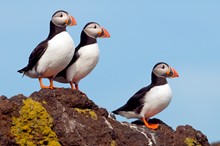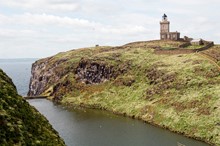19 March, 2018
Isle of May opens for the season
Puffins - the Isle of May’s most popular annual visitor - are set to make a welcome annual return at the end of this month, when the national nature reserve opens again to the public.
A record-breaking almost 13,000 visitors came ashore to the Scottish Natural Heritage (SNH) national nature reserve in 2017 for the chance to see thousands of spectacular seabirds, including the largest concentration of nesting puffins along the east coast; and learn about the island’s cultural heritage.
David Steel, SNH’s Isle of May reserve manager said, “This is an exciting time on the May, when we look forward to welcoming the season’s first visitors, and our first seabirds’ return, including the ever-popular puffins. In this, the Year of Young People, we’ll also be working with a range of youth groups, with some of them meeting puffins for the very first time.
“There’s a whole variety of events coming up this season, including family fun days and a weekend celebrating the island’s seals. There will also be free, open access to the Stevenson lighthouse. My advice to visitors of all ages, is: for close-up views of truly characterful birds, book your place on a boat soon!”
ENDS
Background information
The May is open almost daily (weather dependent) from 31 March to 30 September with boats sailing from Anstruther harbour.
It’s free to visit the nature reserve, but you must take a boat trip to reach the island. Sailings are on the privately-run May Princess or Osprey of Anstruther from the Anstruther Harbour or through the Scottish Seabird Centre in North Berwick.
- Anstruther - for tickets and details, see www.isleofmayferry.com (May Princess) or www.isleofmayboattrips.co.uk (RIB Osprey).
- North Berwick - For tickets and details, book online on the Scottish Seabird Centre website at www.seabird.org or call 01620 890 202.
Known locally as 'The May', this small island sits on the edge of the Firth of Forth. The island's importance for seabirds has drawn scientists to its shores for many years and the May is home to the oldest continuously running bird observatory in the UK. The May is also a regular haunt for grey seals, often seen lounging on the shoreline rocks. This island is a historical gem and has been a place of pilgrimage for centuries with an early island monastery. The May was also the site of Scotland's very first lighthouse, built in 1636, while the current, castle-like lighthouse was designed by the engineer Robert Stevenson.
ENDS
PHOTO CREDIT - SNH
MEDIA QUERIES - for more information, contact SNH media & PR officer, Carrie Wieteska on carrie.wieteska@snh.gov.uk or 0131 316 2631 or the SNH main press office in Inverness on 01463 725 022.
Contact information
- Name
- Carrie Wieteska
- Carrie.Wieteska@nature.scot
Notes to editors
Scottish Natural Heritage is the government's adviser on all aspects of nature and landscape across Scotland. Our role is to help everyone understand, value and enjoy Scotland's nature now and in the future. For more information, visit our website at www.nature.scot. SNH Media is also on Twitter at http://twitter.com/nature_scot
The Isle of May is one of about 50 NNRs in Scotland. NNRs are special places that look after some of the best of Scotland’s nature on behalf of everyone who lives or visits Scotland, and they provide unique opportunities to visit, enjoy and learn more about Scotland’s nature. For more information, see www.nnr-scotland.org.uk.
NatureScot is Scotland's nature agency. We work to enhance our natural environment in Scotland and inspire everyone to care more about it. Our priority is a nature-rich future for Scotland and an effective response to the climate emergency. For more information, visit our website at www.nature.scot or follow us on X at https://x.com/NatureScot
’S e NatureScot buidheann nàdair na h-Alba. Bidh sinn a’ neartachadh àrainneachd na h-Alba agus a’ brosnachadh dhaoine gu barrachd suim a chur ann an nàdar. Tha e mar phrìomhachas againn gum bi nàdar na h-Alba beairteach agus gun dèilig sinn gu h-èifeachdach le èiginn na gnàth-shìde. Tha an tuilleadh fiosrachaidh aig www.nature.scot no air X aig https://x.com/NatureScot


